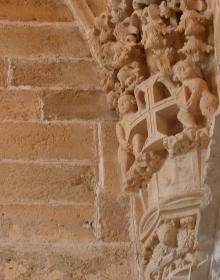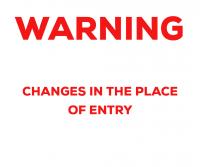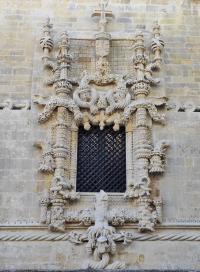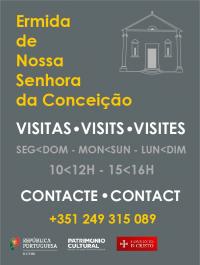- HOME
- MONUMENT
- Convent of Christ
- History
- Architecture
- Personalities
- King Afonso Henriques
- D. Gualdim Pais
- King Dinis
- King John I
- D. Lopo Dias de Sousa
- King Duarte
- Prince D. Henrique (Henry
- King John II (1455 - 1495
- King Manuel I (1469 - 152
- Diogo de Arruda
- João de Castilho
- Jorge Afonso
- Olivier de Gand
- King John III (1502 - 155
- Diogo de Torralva
- Friar Anthony of Lisbon
- Baltazar de Faria
- Filipe Terzi
- Philippine Dinasty
- King Philip II of Spain
- King John IV
- Domingos Serrão
- Queen Mary II
- Prince Fernando
- Costa Cabral
- Artisans and Artists
- Intangible Heritage
- Related Heritage
- Glossary
- VISIT OUR MONUMENT
- HERITAGE LEARNING
- TOMAR
- MONASTERIES ROUTE

The Order of Christ
By not accepting this order, King Dinis, however, provisionally annexes all Templar assets to his Crown and skilfully initiates diligences with the Holy See to create a new religious militia, claiming the need to defend Portugal from Islam close from bordering North Africa and the Andaluz region. After four years of negotiation, King Dinis is granted permission to found the new military religious order.
On March 19th of 1319, through Pope John XXII´s bull, the Ordo Militae Jesu Christi, or Military Order of Our Lord Jesus Christ, is instituted and with it King Dinis incorporates the Knights Templar, their assets and privileges from the now extinct Order of the Temple. Initially the new militia will have its base close to the river mouth of Guadiana, in Castro Marim. D. Gil Martins of the Avis Order will be its first Master.
Similarly to what had previously happened with Knights Templar, the Order of Christ follows the Cistercian rule and the Alcobaça abbot remains their spiritual judge and visitor. The knight´s habit is similar to the one worn by the original Knights Templar - white with a red cross, differing slightly in shape. Whereas Knights Templar had a curved line in the arm zone, the militia of Christ´s cross had a straight line with serifs at the ends and filled-in white at the centre.
The new Cavalry keeps its subordination to the king - all administrative, goods conveyance, change in costumes or destitution of commanders or friars had to be previously approved by the King.
The headquarters of the Order of Christ is set up in the former Knights Templar headquarters in 1357 - the Tomar Castle - where it will remain.
With the passing of Master D. Lopo Dias de Sousa in 1417, King John I receives the nomination by the Holy See for his son - Infante D. Henrique - to be governor and keeper of the Order of Christ.
The Capitulum gathered in Tomar in 1421 marks the beginning of the reforms that the Infante (Prince) will make in at the core of the militia. The Rule of the Calatrava Order was adopted resulting in the Order of Christ to be free of spiritual dependency and obedience to the Cistercian rule while at the same time the Knights kept the status of friars.
The Order will open itself to lay life and to civil society in general, with the discovery of new lands and seas - now, one of their missions too. Under the new governance by the Infante (Henry, the Navigator), many of the Order of Christ Knights became navigators and vice-versa. In order to achieve this, the prince attains from the Pope the institution of partial vote of poverty - allowing the Knight and his family, by inheritance, to benefit of a third of the goods acquired for the Order.
On the spiritual field, a branch of contemplative friars is introduced in the Order with the intent of praying for those overseas and train priests for evangelization and settlement of new territories. The Order is therefore definitively linked to the spiritual nature of the newly found territories.
The Infante consecrates the exercise of governing the Order to the royal family by appointing as his universal heir D. Duarte´ second son, his nephew D. Fernando and, thus, D. Manuel, nephew grandson of the Infante will, at the age of 14, receive the mastery of the Order of Christ. Upon the premature passing of the royal heir, D. Manuel is appointed by King John II as the successor to the throne. D. Manuel is King of Portugal, governor and keeper of the Order between 1495 and 1521.
It is with King Manuel that the Order will have its deepest involvement in the enterprise of the Discoveries - both on a spiritual level, by appointing to the Order the ecclesiastic of the parishes overseas, as well as on a temporal level by giving the Knights the possibility of exempting the chastity vows to those who wished to establish family overseas. Under King Manuel, the Order is given an immense power spread throughout the entire Portuguese empire.
King John III, with a completely different vision of State from his father´s will, perpetrates a dramatic and profound reform within the Order. With the Discoveries well under way, and influenced by the Counter-Reform spirit of the Church of Rome, King John III constricts the religious friars of the Order to observance of a life of enclosure.
The leading figure of this reform will be Friar António da Silva - thought to be from Lisbon and religious man of the Jerónimos of Guadalupe - and confessor of the King. John III also obtains from the Holy See the right for Portuguese Kings to perpetually become masters of the Order of Christ.
When Portugal loses its independence in 1580, the Spanish King Philip II, heir to the Portuguese throne, also becomes the master of the Order of Christ as well as the Spanish monarchs that succeeded him.
With the restoration of independence in 1640, the new Portuguese King John IV re-establishes the branch of cavalry of the Order of Christ with an original innovation: The new Knights also become secular religious brothers of the Order. These Knights lived outside the convent with their families and had a special rule for their secular life. The mission of these Knights was, mainly, to fight in the Restoration war.
The character of the secular religious Knights is definitely consecrated in 1779 with Queen Maria I´s reform. With the extinction of male religious orders in 1834, the Order of Christ became extinct. However, Queen Maria II decides to keep the Order of Christ as an Honorary Order. Currently, the Order of Christ holds that same degree and its Grand Master is the President of the Portuguese Republic.
SERVICES - ACTIVITIES




